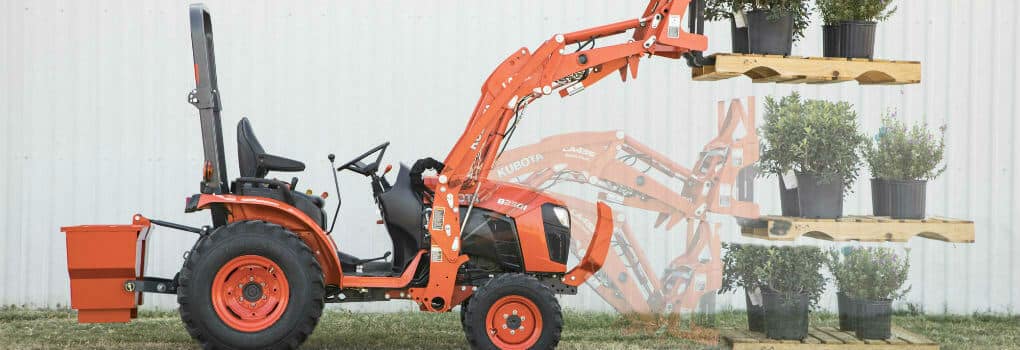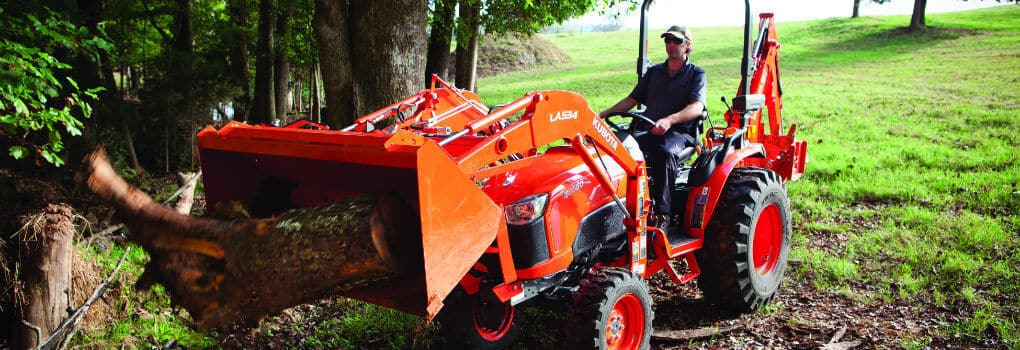
Operating a new tractor requires training and thorough studying of the manual instructions. Even experienced operators can misuse machinery in an inefficient manner that causes wear and tear to various areas without knowing it. More importantly, not knowing how to operate a front end loader properly could put you and bystanders at risk of injury or death.
Although skid loaders and heavy equipment wheel loaders are technically front end loaders, we’re only considering tractor front end loaders in this article.
4 Tractor Front End Loader Techniques, Tips, and Tricks
Here are some common tractor front end loader operating tips to help you avoid any mishaps and keep your loader in tip-top shape.
1. How to Drive a Front End Loader
When driving with a load in the bucket, the best practice is to position the bucket just below the tractor hood for maximum stability and visibility. Do your best to load the bucket evenly and within the loader’s recommended capacity.
Keep your speed slow and stay vigilant for obstacles when raising or lowering the load. Carry loads as low as possible and never travel with the bucket in a raised position. Exercise extra caution when turning as the movements can cause contents to shift or slide. Loading or turning at the same time could easily overturn the machine.
Even when at a stand-still, maxing out your vertical lift could cause the load in your bucket to spill onto the hood of your Kubota tractor, causing damage and even injury to the operator (you).
2. Digging with a Front End Loader

Digging with a front end loader is difficult, but possible. A common mistake many operators make is using the loader as a “scoop” by angling the bucket forward. This may cause you to lose traction and the load itself while putting more stress on the drive train. Keep the bucket level, then lift and skim the load. You can try wiggling the edge by moving the joystick forward and backward but do not ram the dirt (which could cause damage to the bucket and ram cylinders).
If you frequently use your front end loader to dig, consider opting for a Kubota TLB so you have the right tools at your disposal.
3. How to Grade with a Front End Loader
Grading with a front end loader takes slow and steady patience. Work in sections at lower speeds to avoid having to do multiple passes and corrections, and always back-drag while grading.
If you’re moving dirt, sand, or gravel, make sure you limit your loads and that all the material is being placed in the right location. Match each pass (about a half-bucket wide) with the existing grade and try a diagonal pass if the grade is still not level after a few tries. Use the bucket tilt to make any corrections.
Grading a Gravel Road with a Tractor
To avoid potholes and mud puddles, periodically grading gravel with a tractor is a must. A simple method is to scrape at the surface and smooth the “crown” (the higher areas) into the potholes to level the surface.
Back-drag the gravel for a smoother finish and compact the road by wheel-rolling over your work with the tractor. Getting below poor drainage areas is the key to stopping potholes and washboard from returning too quickly.
4. How to Stop Wheels from Spinning
Spinning wheels cause premature wear and inefficient work. When you break traction, lock the front axle so power is distributed to both of the front tires instead of just one to lessen spinning. Having the correct pressure and tread pattern can also help reduce spinning and increase productivity.
Front End Loader Safety Tips
The most common risks from operating a front end loader include rolling over or hurting bystanders. Now that we’ve covered our front end loader tricks, study these safety practices and tips on dealing with weight imbalance and other dangers.
Carrying a Load On a Slope
When driving on a slope, the standard safety tip is to keep the bucket as low as possible. This gives the machine a lower center of gravity to provide more stability and avoid tipping. Never drive across- it’s only safe to operate up and down a slope. When driving with a load, drive forward if heading uphill and back downhill carefully.
Driving a Tractor on Uneven Terrain
When driving on uneven terrain, the rougher it is the more careful you need to be. If applicable, you may want to remove the mower deck to avoid any accidents. To prevent bouncing make sure to avoid holes, rocks, and similar obstacles on the ground and be mindful of overhead wires, lines, etc. Before you lift a load, make sure you are on stable ground otherwise you may tip over even when still.
Follow Manufacturer Instructions

Front end loaders are heavy and dangerous machinery and should be treated as such. Only operate the machine when seated (and buckled in) and make sure there are no people close by when operating. Never lift or carry people in the bucket for a ride – it’s not worth the risk.
Front end loaders are also not meant to tow or knock things down. Avoid using the bucket as a platform and do not allow anyone to walk under it under any circumstance.
Hydraulic Oil Leaks
Hydraulic oil can deeply penetrate the skin under pressure and cause serious injury. To avoid any tragedies, make sure all hydraulic pressure is relieved before disconnecting any lines. Oil injection injuries also occur from pinhole leaks which are often overlooked before worsening. Use pieces of paper or cardboard to check for these kinds of leaks.
Contact Bobby Ford Tractor and Equipment for All Your Front End Loader Needs
When you need a reliable machine at a fair price, trust Bobby Ford Tractor and Equipment, your authorized Greater Houston Area, Texas Kubota Dealer. For more information on a tractor, Kubota tractor repair, or for a quote – contact us today!
The content on this site reflects my own opinions and does not necessarily reflect the views or opinions of my employer or Kubota Tractor Corporation.

